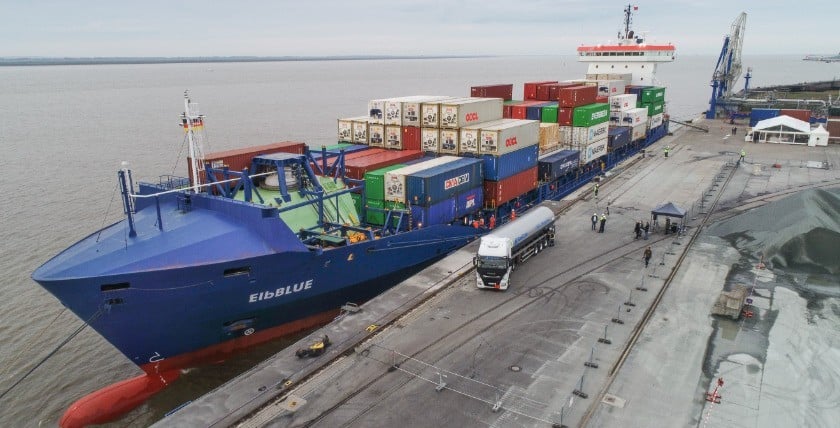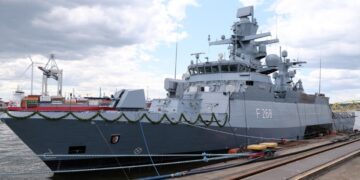On 29 September 2021, the first commercial Container ship refuelled with CO2-neutral synthetic LNG in Brunsbüttel. This means that the Limassol-registered "ElbBLUE" is now the first ship in the world to run on synthetic natural gas (SNG).
Built in China in 2012, the Container ship with a length of 153 metres and a displacement of 13,200 tonnes can transport 1,036 containers. Originally powered by heavy fuel oil, the MAN 8L48/60B diesel engine from MAN Energy Solutions was converted to the MAN 51/60DF four-stroke engine in 2017. At the time, the ship was still called the "Wes Amelie" and attracted international attention with its drive unit. The so-called multi-fuel engine enables the use of liquefied natural gas (LNG) as a fuel. The modernisation of the engine already led to a reduction in emissions, even when using conventional fuel. The complete switch to gas operation and the increasing use of synthetic fuels such as SNG in the future should enable one hundred per cent climate-neutral operation.
The Federal Government's coordinator for the maritime industry, Norbert Brackmann MdB, said on site: "With the first refuelling of a container ship With synthetic, CO2-neutral LNG, we are taking a big step towards the maritime climate transition and the zero-emission ship. Because engines that burn fossil LNG today will be fuelled with climate-neutral LNG tomorrow. We are already here with the refuelling of the "ElbBLUE". 'Tomorrow' has become 'today'. That's a real milestone!"
The German politician's euphoria is understandable. The member states of the International Maritime Organisation (IMO) had agreed on a reduction target for 2050 of at least 50 percent compared to 2008. Stricter limits for engines have been in place since 2019/2020.
Refuelling by tanker
The "ElbBLUE" was fuelled with 20 tonnes of SNG, which was produced in a power-to-gas plant in Emsland and delivered by lorry. In Werlte, Lower Saxony, MAN Energy Solutions built the world's first industrial plant of its kind for a car manufacturer. Renewable energy that cannot be fed into the grid is used to produce hydrogen and oxygen through electrolysis. In the next step, a methanisation reactor uses carbon dioxide obtained from the plant's emissions. This turns the resulting methane into CO2-neutral SNG. In operation since 2013, the power-to-gas reactor in Werlte can produce up to 1,300 cubic metres of green hydrogen per hour. A plant for the liquefaction of SNG was put into operation in 2021.
The German government is funding the research and development of alternative fuels for ships as part of the 'MARITIME.green.Propulsion' maritime research programme. In addition to LNG, the future energy sources ammonia, hydrogen and methanol are being researched with regard to their suitability for use in shipping. According to the responsible Ministry for Economic Affairs and Energy, 58 million euros will be available next year.
Not without controversy ...
... is the use of LNG. In the past, European legislators and environmentalists tried to push LNG out of the FuelEU shipping legislation. They feared that its increased use would slow down the development of energy sources such as batteries, hydrogen and ammonia.
At the same time, many ship operators are relying on LNG as a strategy for decarbonisation. This could result in greater use of LNG, at least in the medium term. Some see LNG as the dominant fuel for ocean-going vessels in the future.
The euphoria in Berlin is relativised by the fact that the "ElbBLUE" could not be supplied directly on site. SNG is currently produced in just a few locations. There are no large industrial plants.
Possible application domain Marine
Experts believe that navies will continue to rely heavily on fossil fuels to power their surface combatants. Except for the French and US Navy aircraft carriers, surface combatant fleets rely on fossil fuels and "will continue to do so for at least the next half century," says Daniel Morris, Lead Analyst at GlobalData Aerospace, Defence and Security, a leading data and analytics company.
The fuel cell system is a noteworthy alternative type of propulsion in navies. In addition to conventional diesel generators, German Navy submarines also have fuel cell systems. Submarines of the French Navy, the Royal Navy and the US Navy are nuclear-powered.
The US Navy, which plays a pioneering role in many technological developments, sees a way forward in the use of biofuels and energy efficiency measures. The 'Great Green Fleet' initiative, which was initially (2009) motivated by the expected cost savings, was implemented for the first time in 2016. The US Navy landing ship "USS Makin Island", which is part of the aircraft carrier group around the "USS John C. Stennis" and has a diesel-electric propulsion system, was refuelled with a diesel-biofuel mixture.
Research into alternative fuels plays a major role for the US Navy. Its philosophy is that they should not entail any changes to the current aircraft or ship systems. It is therefore focussing on a mixture of conventional fuels and alternative fuels. The trials conducted by the US Navy as part of the 'Great Green Fleet' led to a 50 per cent reduction in non-tactical oil consumption. The Navy leadership calculates a saving of 248 million US dollars in energy costs through energy efficiency measures and the use of biofuels over the entire service life of the "USS Makin Island". The possible energy measures include shipbuilding changes, e.g. in the propeller design, underwater hull (including underwater hull protection), operational organisational interventions and optimisation of energy management on board.
The use of sustainable fuels and the US Navy's approach require international cooperation in order to continue to enable interoperability. In other words, at least agreements within NATO and the EU (mil).












0 Kommentare